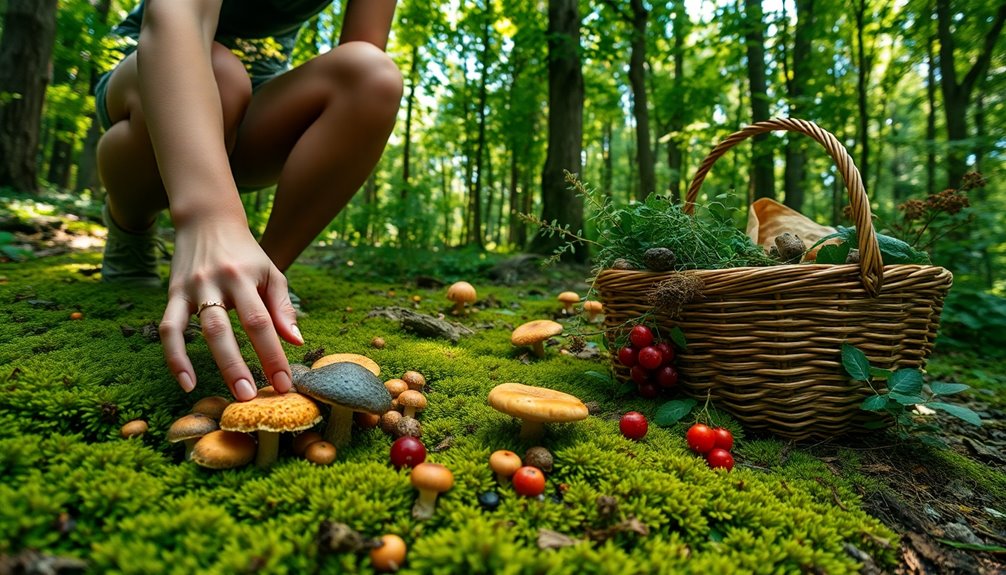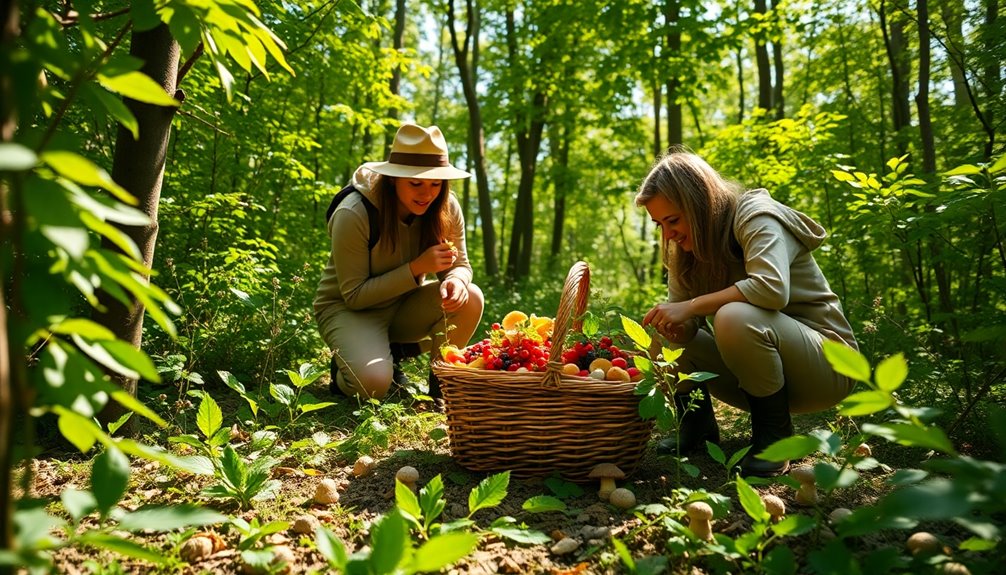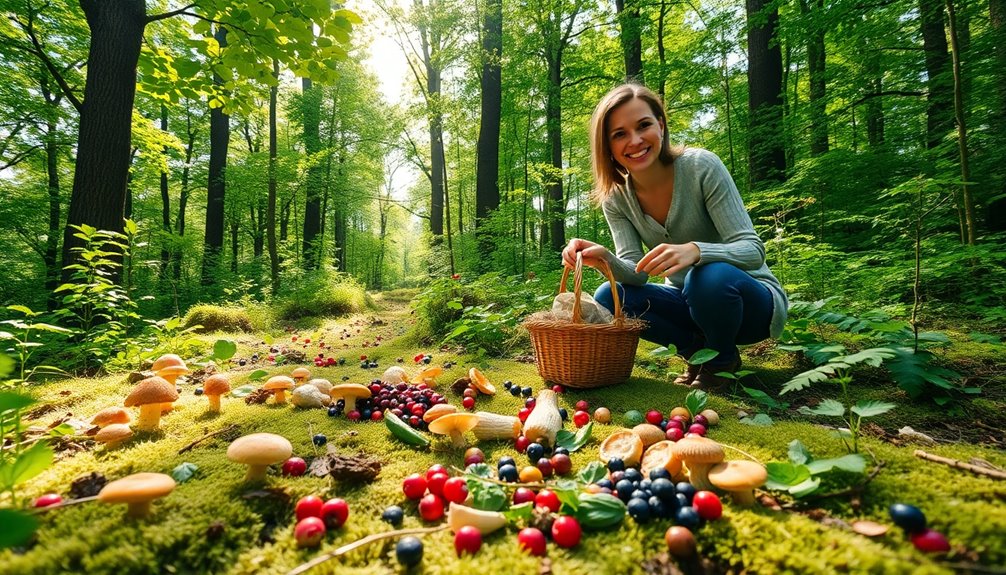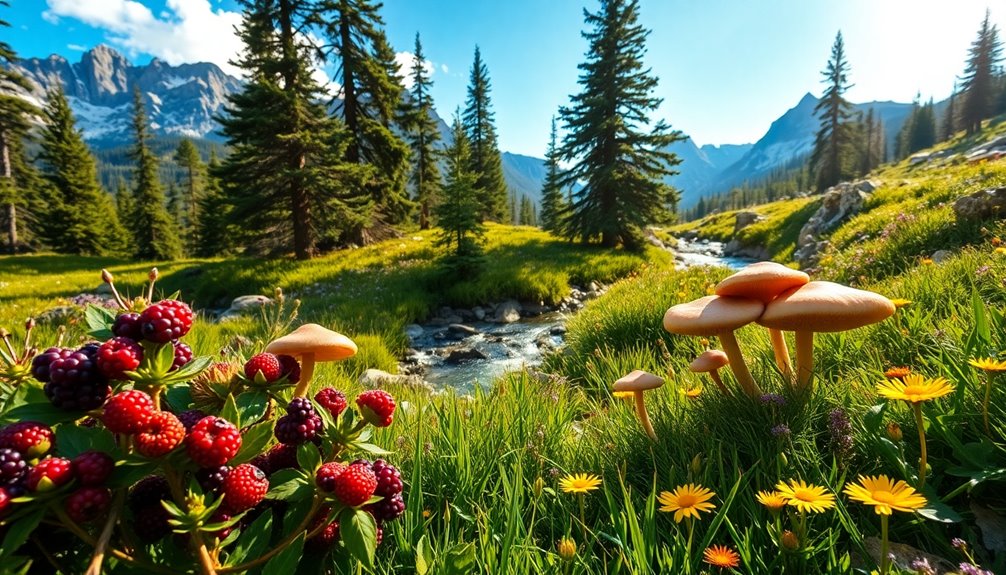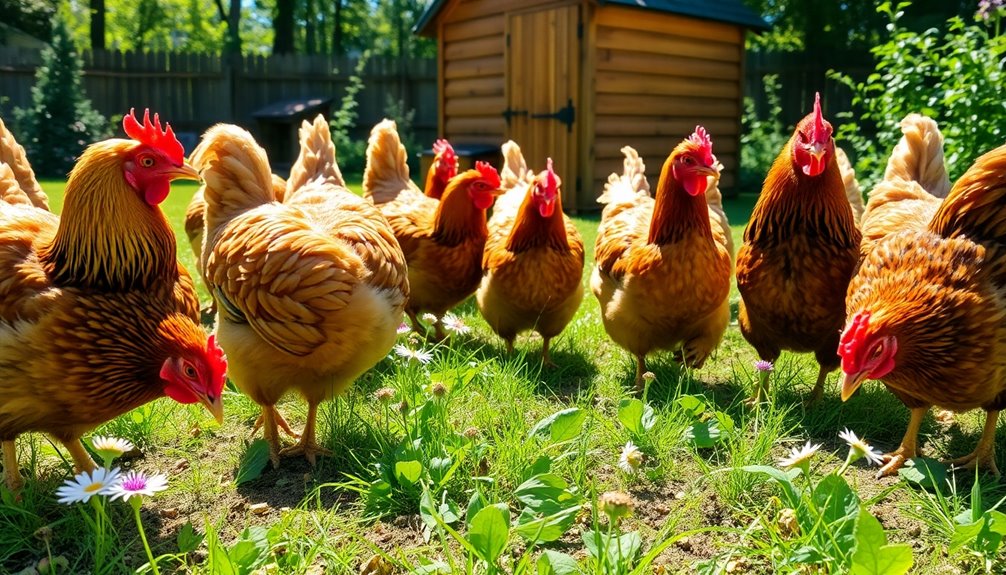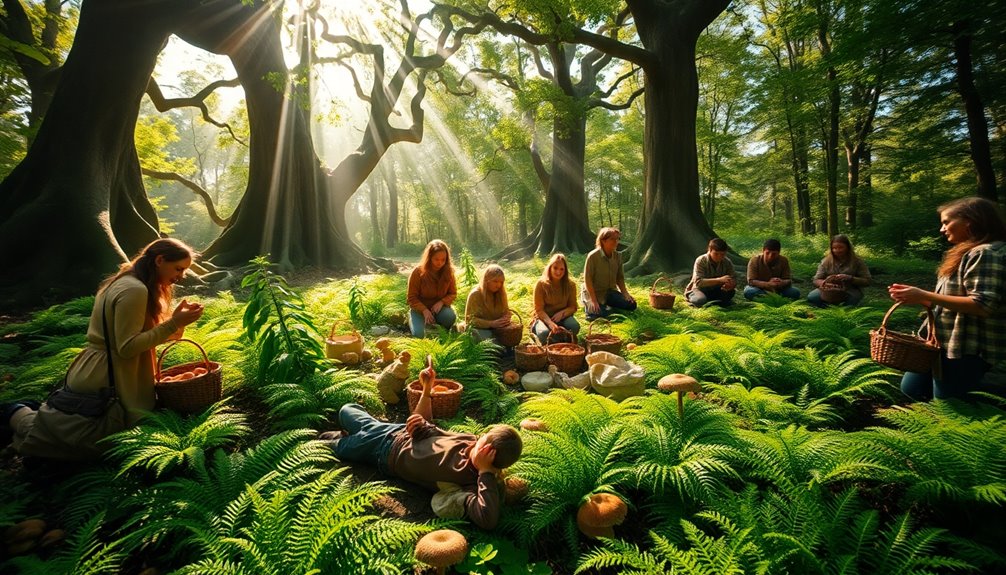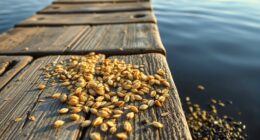You can definitely make money foraging, and it might surprise you how much. With potential earnings up to $200 per hour, foragers can earn between $2,000 and $3,000 annually by selling wild mushrooms and plants. Restaurants pay between $12 and $25 per pound for quality mushrooms, making this a profitable side hustle. Plus, knowing peak harvesting seasons can boost your earnings. Just remember, proper identification and safe foraging practices are essential. Curious about the best ways to start and what to foray? There's a lot more you can discover to enhance your foraging journey!
Key Takeaways
- Foragers can earn up to $200 per hour, with annual incomes between $2,000 and $3,000 from selling wild mushrooms and plants.
- High demand from chefs results in prices between $12 and $25 per pound for quality mushrooms.
- Understanding seasonal demand can significantly enhance profit potential by aligning harvests with market needs.
- Selling foraged items at farmers' markets or online creates opportunities for supplemental income.
- Predictive analytics can optimize pricing strategies based on demand forecasting to maximize profits.
Understanding Foraging Profitability
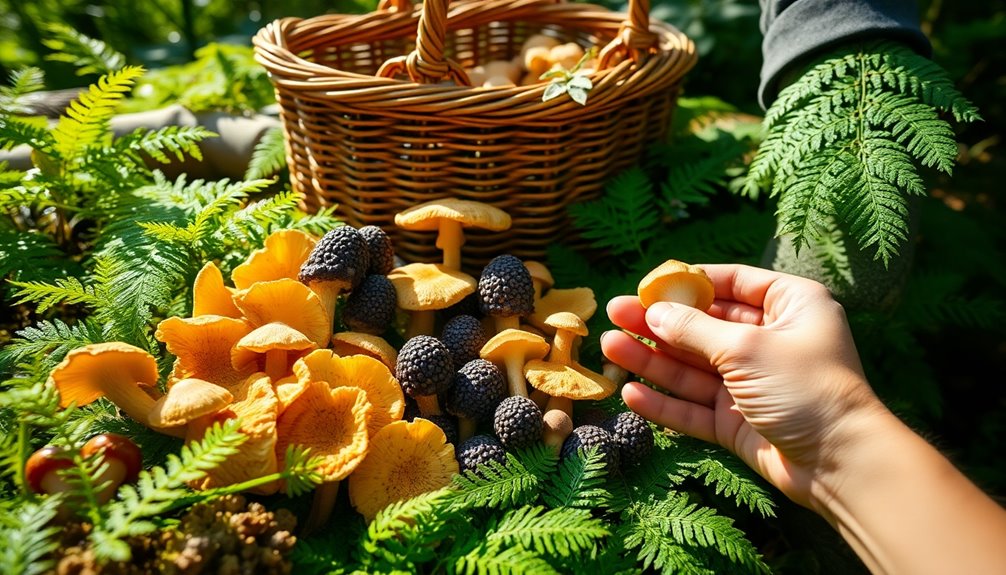
Foraging offers an exciting opportunity to generate income, blending passion with profit. If you immerse yourself in the world of edible plants, you could discover a lucrative side hustle. Reports highlight that foragers can earn up to $200 per hour, with annual incomes ranging from $2,000 to $3,000 by selling wild mushrooms and other plants.
Imagine finding a five-pound chicken of the woods mushroom that you can sell for around $100! Chefs are often willing to pay between $12 and $25 per pound for prime edible mushrooms, making this an enticing market for anyone willing to put in the effort.
Joining foraging groups can enhance your knowledge and help you tap into this profit potential. You'll learn about seasonal harvesting and discover which mushrooms or plants are in high demand. Additionally, participating in local farmers' markets can provide a platform for selling your foraged items directly to consumers.
For instance, harvesting 120 pounds of mushrooms can net you over $2,500 in a short time, showcasing the financial rewards that await dedicated foragers.
Before you start, be certain you familiarize yourself with local regulations and sustainable practices to guarantee a thriving foraging experience. With the right approach, foraging can be a fulfilling and profitable venture.
Essential Foraging Skills
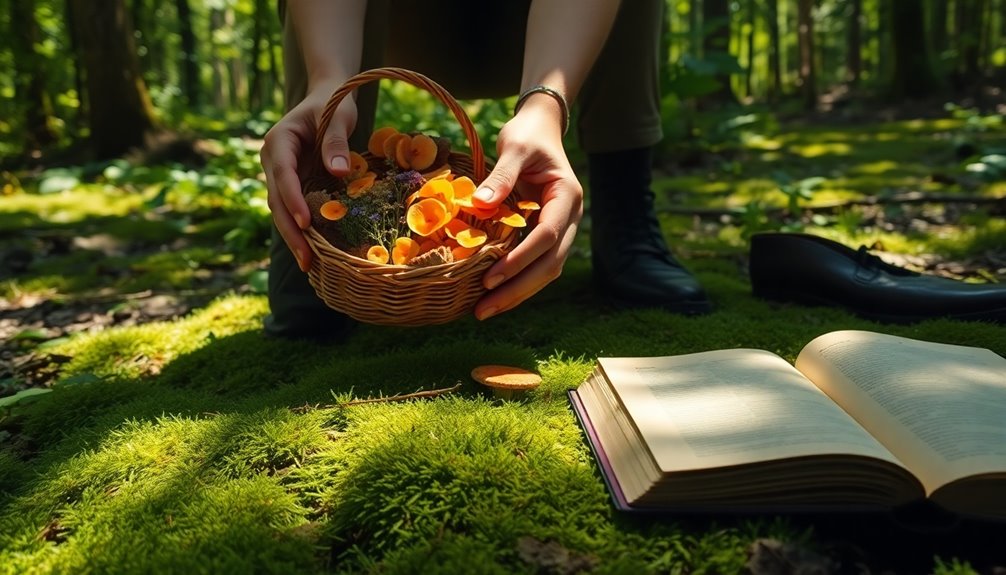
To succeed in foraging, you need to master the identification of edible species and practice safe foraging techniques. Knowing which mushrooms are safe to eat can mean the difference between a delicious meal and a trip to the hospital. Equip yourself with the right tools and knowledge to guarantee you're gathering only the best nature has to offer. Additionally, understanding how to identify non-perishable items can enhance your foraging experience by complementing your gathered food with long-lasting supplies.
Identification of Edible Species
Identifying edible species is a skill that can make or break your foraging experience. With fewer than 100 edible mushroom species compared to around 250 toxic ones, accurate identification is vital. You don't want to risk your health by misidentifying a plant or mushroom.
Even though it might feel overwhelming at first, engaging with an experienced forager can greatly enhance your knowledge and confidence. They can guide you through recognizing safe species and help you avoid common mistakes. Understanding their foraging range is also critical, as it can inform you about where to find certain edible species. Additionally, many educational resources, such as STEM toys, highlight the importance of careful observation and critical thinking, skills that are equally valuable in foraging. Furthermore, the skills developed in foraging can also enhance one's emotional well-being, similar to the effects of pet therapy in caregiving contexts. As with investing in a Gold IRA, making informed decisions and seeking guidance can lead to successful outcomes in foraging.
Using regional guidebooks, like Michael Kuo's "100 Edible Mushrooms," can also be a game-changer. These resources provide essential information about local edible species, including their characteristics and habitats.
Additionally, joining local foraging groups offers a supportive community where you can learn from shared experiences and gain insights from knowledgeable members. For instance, many regions, such as Minnesota's diverse ecosystems, boast a rich variety of wild edibles that can enhance your foraging adventures.
#
Safe Foraging Practices
Understanding safe foraging practices is just as important as knowing what's edible. When foraging, especially for mushrooms, remember that fewer than 100 species are safe to eat while around 250 are toxic. Accurate identification is essential to avoid dangerous missteps. Engaging with an experienced forager or enrolling in classes can greatly enhance your skills.
Foraging in urban areas needs special caution. Avoid spots near sidewalks, old houses, and industrial sites to limit your exposure to contaminants. Always assess local environmental conditions, particularly regarding pesticide use, since roots pose a higher contamination risk. Additionally, being aware of local regulations and foraging ethics can help ensure a responsible foraging experience.
Utilizing regional guidebooks and reputable online resources will deepen your knowledge of local flora, making your foraging experience not only safer but also more rewarding. Here's a quick reference guide to keep in mind:
| Foraging Aspect | Safe Practices | Risks to Avoid |
|---|---|---|
| Edible vs. Poisonous | Learn to identify safe species | Misidentifying toxic varieties |
| Urban Foraging | Choose clean areas away from pollutants | Foraging near industrial sites |
| Environmental Conditions | Check for pesticide use | Ignoring local contamination |
| Foraging Resources | Use guidebooks and online resources | Relying solely on memory |
| Experience | Partner with seasoned foragers | Foraging alone without guidance |
## Safe Foraging Practices
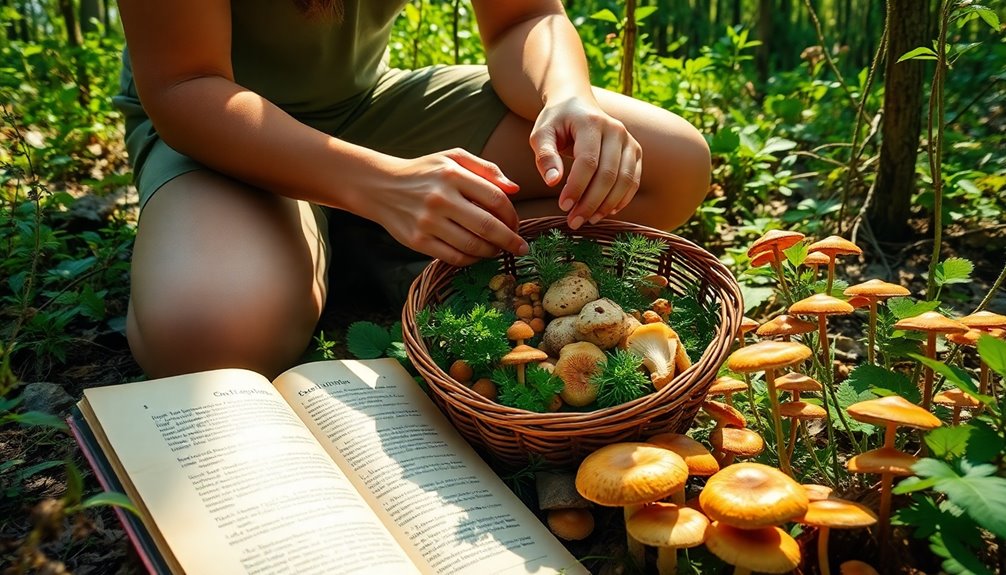
Foraging can be a rewarding adventure, but safety should always come first. To guarantee a safe foraging experience, keep these essential practices in mind:
- Choose Your Locations Wisely: Avoid foraging near sidewalks, old houses, busy roads, railroad tracks, and industrial sites. These areas can be contaminated and pose health risks.
- Conduct Pollution Assessments: Always evaluate the area for pollution on a case-by-case basis. Talk to neighbors about pesticide use and local environmental conditions to gather valuable information. Understanding how environmental modifications can reduce access to foraging areas is crucial for safety.
- Understand Risk Hierarchy: Roots are the riskiest parts to forage, followed by leaves and fruits. Be especially cautious in urban environments where contamination is more likely.
- Educate Yourself on Species: Familiarize yourself with edible versus poisonous plants. With fewer than 100 edible species out there compared to around 250 poisonous ones, misidentification can lead to serious health issues.
Consider connecting with experienced foragers who can guide you in identifying edible plants safely. Additionally, understanding the concept of self-regulation can help you remain calm and focused while foraging, ensuring you make safe and informed choices.
Best Foraging Resources
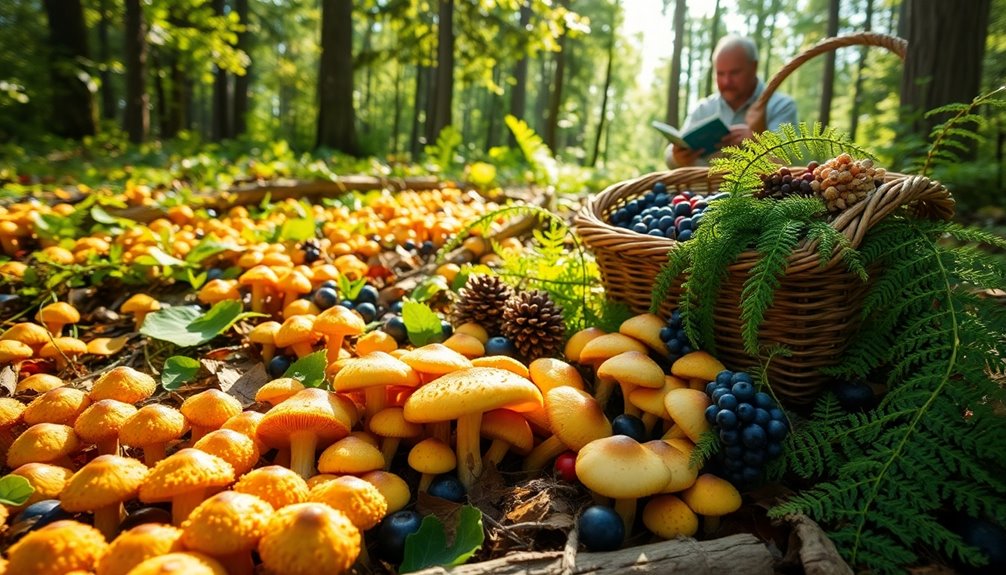
When you're keen to explore deeper into the world of foraging, having the right resources can make all the difference.
Start with regional guidebooks like Michael Kuo's "100 Edible Mushrooms" and Ellen Zachos's "Backyard Foraging." These books are essential for accurate mushroom and plant identification, ensuring you recognize what's safe to eat.
Online platforms like Facebook and Meetup.com are fantastic for connecting with local foraging groups and classes. Engaging with experienced foragers can offer personal introductions and invaluable insights into edible species and safety practices.
Don't underestimate the power of a simple notebook. Tracking dates and locations of your finds will help you improve your foraging skills over time.
Additionally, consider attending workshops led by professional foragers. Creators like Alexis Nicole Nelson provide educational content that can boost your confidence and knowledge in foraging.
With these resources at your fingertips, you'll be well-equipped to navigate the wild world of foraging, enhancing your skills and potentially increasing your profits.
Key Equipment for Foraging
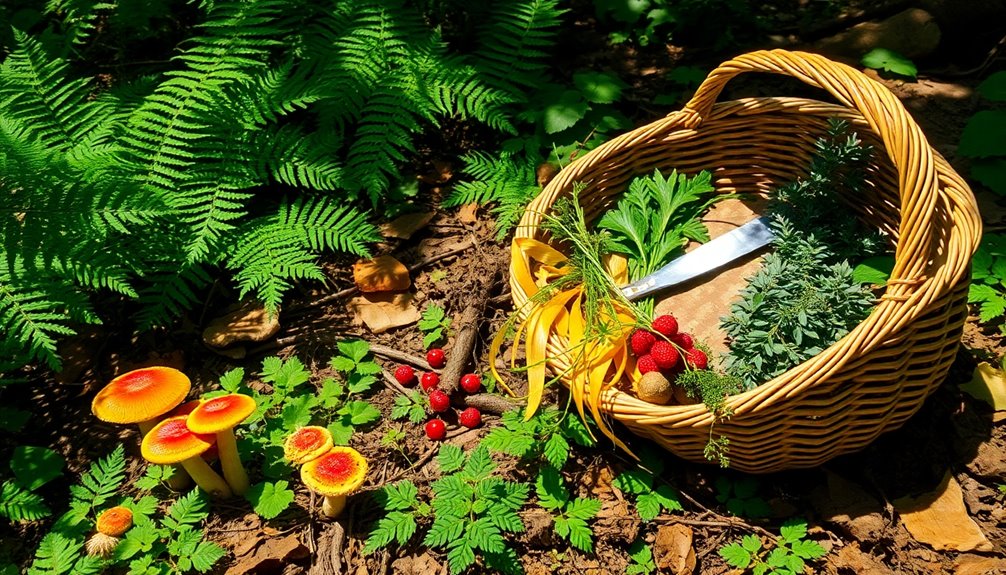
To succeed in foraging, you'll need the right equipment to guarantee a safe and efficient harvest. Having the right tools not only enhances your foraging experience but also protects the items you collect.
Here are four vital pieces of equipment you'll want to have:
- Pocket Knife: This is essential for safely harvesting mushrooms and other foraged items without causing damage.
- Paintbrush: Use this to gently clean debris from mushrooms, ensuring they remain in prime condition for consumption or sale.
- Paper and Plastic Bags: Carry mushrooms in paper bags to prevent rot, while plastic bags work better for plants. This distinction helps maintain the quality of your finds.
- Notebook: Keep track of the dates and locations of your foraging adventures. This will aid in identifying productive spots for future outings.
Additionally, consider using a basket or daypack for easy transport of your foraged goods.
With the right equipment in hand, you'll be well-prepared to explore and gather nature's bounty efficiently and safely. Happy foraging!
Market Opportunities for Foraged Goods
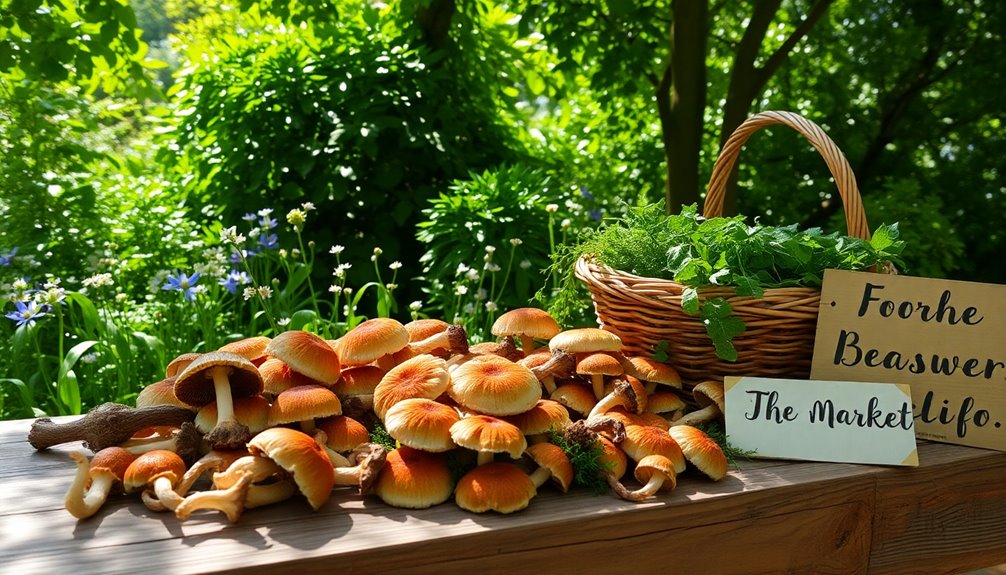
When you're foraging, understanding seasonal demand fluctuations can help you maximize your profits.
You'll want to develop effective pricing strategies for your goods, especially as you target local restaurants keen for unique ingredients.
Seasonal Demand Fluctuations
Seasonal demand fluctuations play an essential role in maximizing profits from foraged goods. By understanding these cycles, you can time your harvests to align with market demand, ensuring you get the best prices.
Here are some key points to evaluate:
- Peak Seasons: Mushrooms like chanterelles and morels often reach $25 per pound during their peak seasons, attracting serious buyers.
- Fall Surge: Interest in wild mushrooms spikes in the fall as restaurants seek unique ingredients for seasonal menus.
- Spring Delicacies: Ramps and wild asparagus are in high demand during spring, commanding premium prices due to their limited availability.
- Trend Tracking: Keeping an eye on local restaurant trends and seasonal menus can help you identify high-demand items, allowing you to sell at peak pricing.
Pricing Strategies for Foraged Goods
Pricing strategies for foraged goods are essential for maximizing your profits in this lucrative market. Knowing how to price your finds can greatly impact your earnings. For instance, chefs are willing to pay between $12 and $25 per pound for high-quality edible mushrooms. This creates an opportunity for you to strategically price your foraged goods based on their condition and market demand. Additionally, understanding the state taxes that apply to your earnings can help you plan your pricing more effectively and retain more of your profits. Furthermore, being aware of seasonal availability can also influence your pricing strategy and enhance your marketability. Regular foraging can contribute to your overall well-being as it encourages outdoor activity and connection with nature. Implementing predictive analytics can also help you forecast demand and optimize your pricing strategies for different foraged items.
Here's a quick reference table to take into account when setting your prices:
| Foraged Item | Average Price per Pound | Potential Earnings for 5 Pounds |
|---|---|---|
| Edible Mushrooms | $12 – $25 | $60 – $125 |
| Chicken of the Woods | $20 | $100 |
| Lion's Mane Mushroom | $10.63 | $53.15 |
| Seasonal Fungi | Varies | Up to $200 per hour |
| Mixed Foraged Greens | $5 | $25 |
Additionally, employing ingenious foraging toys for small animals can enhance their well-being, potentially increasing the demand for foraged goods that cater to pet owners.
Targeting Local Restaurants
In today's culinary landscape, local restaurants are enthusiastic to incorporate unique ingredients that can set their menus apart. This creates a lucrative opportunity for you as a forager. By targeting local eateries, you can tap into a market where restaurants often pay between $12 to $25 per pound for prime condition edible mushrooms.
Here are some reasons to focus on this niche:
- High Profit Margins: A five-pound chicken of the woods mushroom can yield you $100, showcasing the potential for substantial earnings. Additionally, understanding local business hours can help you plan foraging trips effectively. Many regional water parks also engage in similar practices by sourcing local ingredients, demonstrating the growing trend of local sourcing in the food industry. This trend mirrors the collaborative creativity seen in projects like Microcosmic Symphony, where diverse interpretations can elevate a dish's profile.
- Consistent Demand: Establishing relationships with local chefs can lead to consistent sales opportunities, ensuring a steady income stream. Additionally, many chefs seek therapeutic benefits from incorporating foraged ingredients into their dishes to enhance their culinary creations.
- Unique Offerings: Chefs crave unique, seasonal ingredients to elevate their dishes, making foraged edibles an attractive addition to their menus.
- Annual Earnings Potential: With effective marketing, you can earn between $2,000 and $3,000 a year from seasonal foraging.
Additionally, foraging aligns with the principles of vibrational energy, allowing you to connect with nature and enhance your overall well-being.
Community Engagement in Foraging
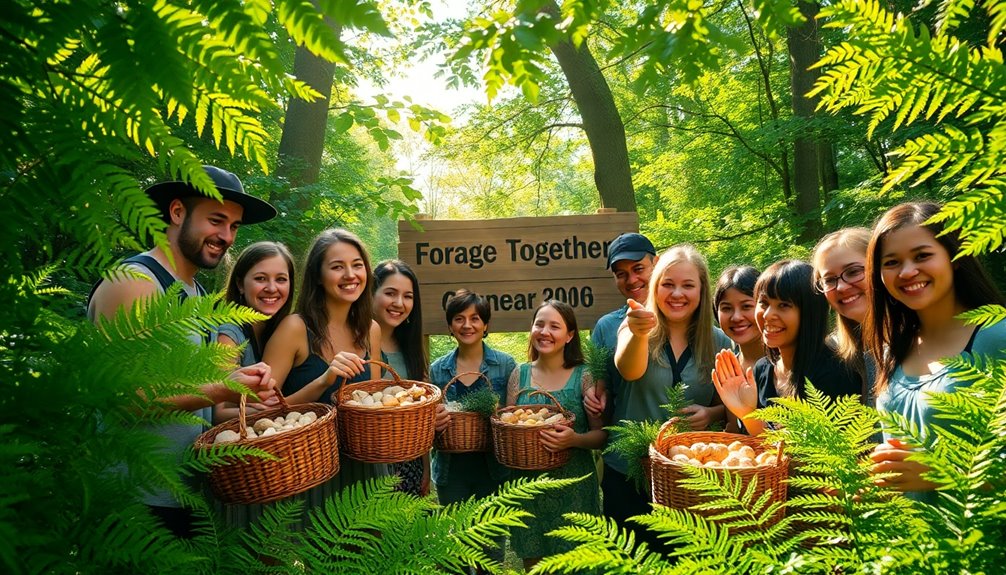
Foraging isn't just about finding food; it's also about building connections within your community. Engaging with local foraging groups through platforms like Facebook and Meetup.com can greatly enhance your skills and safety awareness. These communities provide valuable support, especially for novice foragers, allowing you to learn from others' successes and challenges.
Participating in community classes and workshops, often led by experienced foragers, fosters interactive learning experiences. Here, you can share your insights and gain practical knowledge about the best foraging practices. Networking with neighbors about local plants can also deepen your understanding of environmental conditions and improve your foraging techniques. Plus, it's a great way to cultivate friendships through shared gardening interests.
Influencers like Alexis Nicole Nelson are making strides in promoting urban foraging through social media, helping educate diverse audiences on native species and foraging opportunities. By joining local foraging groups, you not only expand your knowledge of edible plants but also become aware of safety and pollution concerns in specific areas, ensuring a responsible and enriching foraging experience. Additionally, understanding the benefits of aromatherapy can enhance your overall well-being during foraging trips, making the experience even more enjoyable.
Embracing community engagement in foraging truly makes the journey more rewarding.
Culinary Uses of Foraged Plants
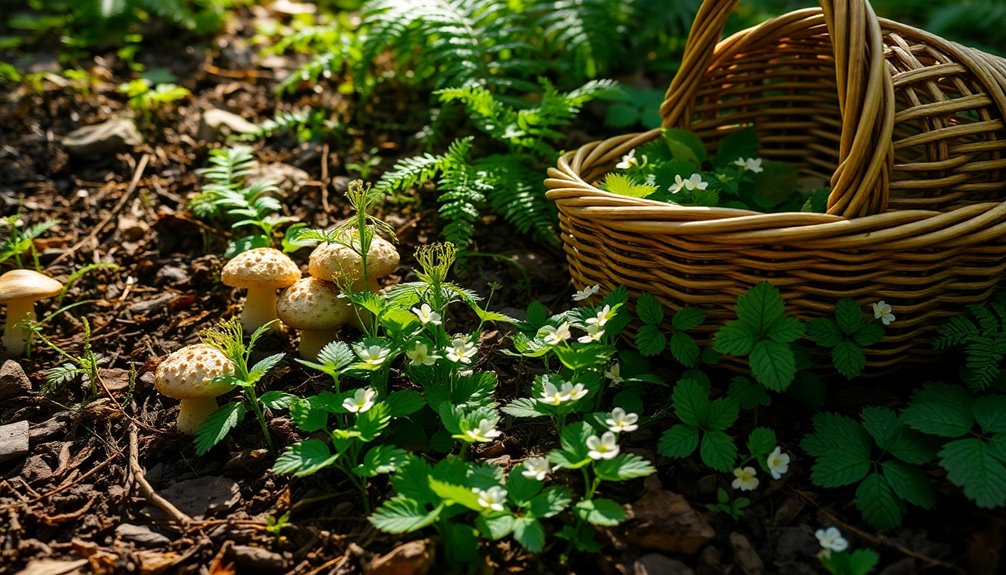
While many people think of foraged plants as simply wild edibles, they can elevate your culinary creations in surprising ways.
These ingredients not only add unique flavors but also showcase your creativity in the kitchen. Here are some culinary uses for foraged plants you mightn't have considered:
- Cherry Trees: Use the blossoms, leaves, and fruits in sushi or desserts to add an elegant touch. Porcelain toilets are known for their durability, making them a great choice for any kitchen.
- Service Berries: Transform these into syrups, jams, or desserts for a sweet and tangy flavor that enhances your dishes.
- Magnolia Petals: Incorporate these petals into salads or as garnishes for an unexpected twist and visual appeal.
- Mulberries: Process both berries and young leaves into a caffeine-free mulberry matcha for a unique beverage option.
To extend the life of these foraged treasures, consider preservation techniques like salt curing for cherry blossoms or fermentation for Juneberries. Additionally, foraged ingredients can be complemented by fermented vegetable plates to enhance their nutritional value and flavor profile.
Frequently Asked Questions
Can You Make Money From Foraging?
Yes, you can make money from foraging! If you know your edible plants and mushrooms, you could earn a decent income.
Imagine harvesting a five-pound chicken of the woods mushroom and selling it for around $100. With the right knowledge and skills, you could even make $200 an hour or more.
Plus, foraging lets you enjoy nature while supplementing your income, making it a fun and rewarding way to earn.
How Much Do Foragers Make?
Imagine wandering through a lush forest, your basket brimming with vibrant mushrooms and wild greens.
As a forager, you can earn anywhere from $2,000 to $3,000 annually, with some days bringing in up to $200.
Picture selling a 33-pound lion's mane mushroom for $351 in just three hours!
Chefs enthusiastically pay between $12 to $25 per pound for your fresh finds, turning your passion into a rewarding side hustle that's both profitable and fulfilling.
What Is the Golden Rule of Foraging?
The golden rule of foraging is to accurately identify edible plants and mushrooms. Since only a small number are safe to eat, you've got to be cautious and well-informed.
It's crucial to engage with experienced foragers or take classes to learn the ropes. Always choose clean areas away from pollution, and remember that safety comes first.
Joining local groups and using regional guidebooks can help you stay safe and knowledgeable in your foraging adventures.
What States Is Foraging Illegal?
In the lush embrace of nature, you might be tempted to pluck wild berries or mushrooms, but beware—the law can be as tangled as the underbrush.
In states like California and New York, foraging is illegal on public lands, while Massachusetts has strict regulations in state parks.
Washington requires permits for mushroom harvesting.
Always research local laws before venturing out; ignorance won't shield you from fines or penalties.
Stay informed and foraging responsibly!
Conclusion
Just like a squirrel stashing acorns for winter, foraging can yield a bounty if you know where to look. With the right skills and safety practices, you can turn nature's treasures into profit. Immerse yourself in community resources and connect with fellow foragers, as each shared story enriches your journey. So, gather your gear, explore the wild, and let the unexpected rewards of foraging fill your basket—both for your pantry and your pocket!

